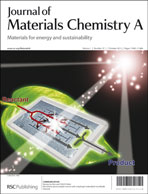We report here a simple and reproducible strategy for fabricating highly durable and robust superhydrophobic cotton fabrics (SCFs) from a series of functional diblock copolymers. These diblock copolymers consisted of both poly(glycidyl methacrylate) (PGMA) and poly(2,2,2-trifluoroethyl methacrylate) (PTFEMA) blocks that were synthesized via sequential atom transfer radical polymerization (ATRP). While the PTFEMA block provides the low surface free energy, the PGMA block serves as an anchor and forms covalent bonds with the surfaces of cotton fibers. These covalent bonds are formed via the epoxy ring-opening reaction between the epoxy groups of the PGMA block and the hydroxyl groups on the surface of the cotton fiber, and self-crosslinking of epoxy groups from PGMA chains. Structures exhibiting nano- and microscale roughness were created in one-step by combining copolymer-based nanobumps onto surfaces of micro-sized fibers of the cotton fabric, as confirmed by SEM and AFM analysis. The modified cotton fabrics show excellent water repellency with water contact angles (WCAs) of ∼163° and water sliding angles (WSAs) of ∼3° under optimized conditions. Since the low-fluorinated PTFEMA chains are chemically bound to the cotton fibers, the SCFs possess long-term stability, ultra-high durability and robustness. In particular, these SCFs withstood mechanical abrasion by sandpaper, strong laundering conditions, ultrasonication treatment in tetrahydrofuran (THF) or trifluorotoluene (TFT), soaking in a wide range of organic solvents, as well as acidic and basic aqueous solutions, exposure to UV-irradiation and even refluxing in TFT or THF.

You have access to this article
 Please wait while we load your content...
Something went wrong. Try again?
Please wait while we load your content...
Something went wrong. Try again?


 Please wait while we load your content...
Please wait while we load your content...